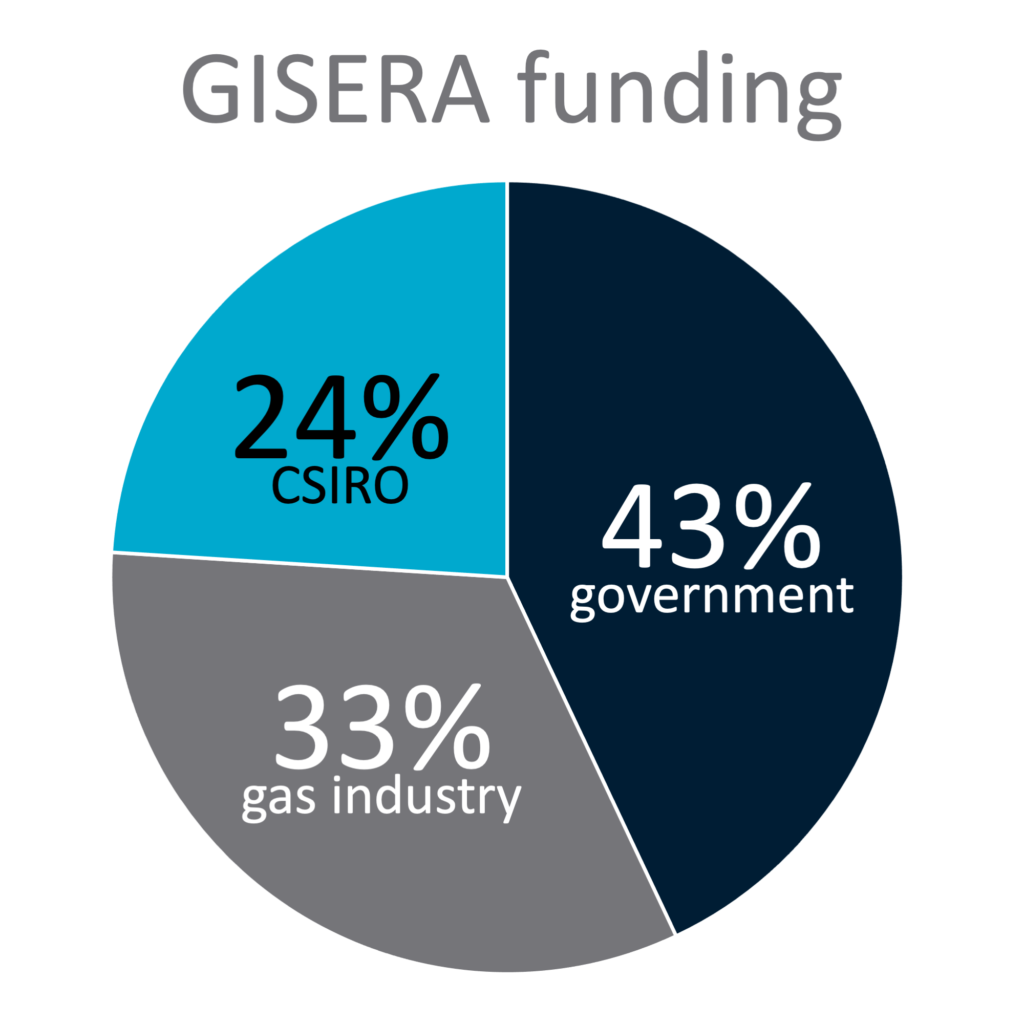Frequently asked questions

Questions about us
Open allClose allGISERA is a research alliance between CSIRO, industry and government that undertakes independent scientific research on the environmental and social impacts of the onshore gas industry in Australia. You can find out more about GISERA on our About us page and from our About GISERA video.
GISERA is a collaboration between CSIRO (Australia’s National Science Agency), industry members (APLNG, QGC, Santos and Origin Energy) and government (Australian Government, Northern Territory Government, New South Wales Government, Government of South Australia and the Queensland Government). GISERA involves community stakeholders on their committees, who suggest and approve research projects. Finally, the researchers involved in approved projects are from CSIRO and other scientific institutions and universities.
GISERA is national and operates predominantly in Queensland, New South Wales, the Northern Territory, Western Australia and South Australia. You can see where our research projects are located via our Research locations page.
All GISERA research is undertaken in the public good. It includes research that answers important questions from the community around the existing and potential environmental, social and economic impacts of Australia’s gas industry.
GISERA was established in 2011. More than 70 projects have been undertaken across multiple states and territories since it began over 10 years ago.
GISERA draws on the expertise of CSIRO scientists across many disciplines including the energy, water, biodiversity, agricultural, health, economic and social sciences. We also collaborate with researchers in other science institutions and universities.
Questions around GISERA governance
Open allClose allGISERA is comprised of state and territory Research Advisory Committees (RACs), which consist of industry, government and community representatives. The RACs review and approve all research projects and community stakeholders make up the majority for each RAC. The GISERA Director and the State and Territory Leaders are involved in RAC discussions but do not have voting rights. You can see the composition of our RACs in each state and territory via our Governance page.

GISERA obtains funding from industry members, Commonwealth, State and Territory Governments, and CSIRO. Volunteer community stakeholders play a major role in the Research Advisory Committees, and research scientists involved in GISERA projects are from CSIRO or from collaborative research organisations and universities.
GISERA research is undertaken by experts, for the public good, using established scientific methods and the high research standards that CSIRO is known for. The peer review process, and the transparent and collaborative nature of the research ensures high-quality, independent science that can be used to inform decision making across industry, government and community.
GISERA conducts its research under an Alliance Agreement, which incorporates the following:
* Research Advisory Committees (RACS) for each state and territory that review and approve all GISERA research projects
* RACs consist of a majority of community stakeholders
* Companies engaged with GISERA do not have the right to alter or edit research reports written by CSIRO under GISERA
* All research is made publicly available once the peer review process has taken place.
Questions about GISERA research
Open allClose allGISERA research investigates community concerns and issues across the research themes of:
* Agriculture and land management
* Greenhouse gases and air quality
* Health impacts
* Social and economic impacts
* Ground and surface waters
* Biodiversity
GISERA research study sites take place where existing and potential onshore gas industry development and exploration occurs. These regions cover the states and territories of Queensland, New South Wales, the Northern Territory, South Australia and Western Australia.
CSIRO scientists and research collaborators from other research organisations and universities work on GISERA research projects. These researchers have expertise that cover the energy, water, agricultural, biodiversity, health and social sciences. You can learn more about GISERA research via our Research page.
Questions about onshore gas
Open allClose allGISERA research projects are based on the environmental and social impacts of onshore natural gas. This includes coal seam gas (CSG), shale gas, tight gas and conventional gas. You can read more about natural gas via our What is coal seam gas? page.
Coal seam gas, or CSG, is a form of natural gas typically extracted from coal seams at depths of between 300 and 1,000 metres. You can learn more about coal seam gas from our What is coal seam gas? video.
Shale gas is mainly methane that is trapped within a clay-rich sedimentary rock at depths greater than 1,500 metres. You can learn more about shale gas from our What is shale gas? video.
Onshore gas is extracted through wells that are drilled into the ground. Conventional gas resources are trapped within layers of permeable rock, which allows liquid and gas to flow through – this makes it possible to extract using conventional techniques. Unconventional gas resources are trapped within less permeable rocks such as shale or coal. Techniques like hydraulic fracturing are used to assist in gas extraction of unconventional gas resources.
Hydraulic fracturing (HF) is a method used by the oil and gas industry to increase the rate and total amount of resources extracted from underground reservoirs. You can read more about hydraulic fracturing on our How is CSG extracted? page.
Predicting the long-term impacts of CSG can be difficult due to the potential cumulative and regional impacts of multiple gas developments. CSIRO GISERA’s research on the impacts of gas must therefore consider variations in:
* the nature of all land use in surrounding areas
* the amount, density and location of surface infrastructure
* the geology of the site
* hydrodynamics
* economics and logistics of producing and transporting gas
* the management and monitoring practices in place.
Questions about the GAB and CSG
Open allClose allThe Great Artesian Basin (GAB) is Australia’s largest groundwater basin and one of the largest natural underground reservoirs in the world. It extends beneath parts of Queensland, New South Wales, South Australia and the Northern Territory.
The Murray Darling Basin (MDB) and the GAB are connected by the upward groundwater pressures exerted by the GAB in central and western New South Wales and Queensland. They are also connected via leakage from rivers and alluvial sediments of the MDB to the GAB where Jurassic and Cretaceous beds are exposed along the western slopes of the Great Dividing Range.
The primary target for coal seam gas (CSG) production are coal seams within specific GAB rock layers – in the Surat and Clarence Moreton Basins, these seams are referred to as the Walloon Coal Measures. CSG is trapped here by groundwater pressure and extraction occurs by drilling into the coal seam and lowering the pressure. You can learn more via our GAB and CSG page.
Extraction of groundwater from aquifers will lead to a change in pressure conditions around the location of extraction. The extraction of CSG can also potentially impact groundwater, depending on the location and method used. The removal of water in the coal seam reduces the pressure of surrounding formation water – this is what allows the gas and produced water to be carried to the surface through the wellbore.
The movement of naturally occurring or introduced chemicals (such as those used for CSG extraction) in groundwater depends on the physical properties of the aquifer or aquitard and the properties of the chemical. Some chemicals dissolve easily in water and move at nearly the same rate as groundwater. Other chemicals tend to attach to sediments or undergo degradation reactions and move much more slowly than groundwater.
Groundwater modelling is undertaken to predict the extent to which coal seams are connected to aquifers, and whether drawing water from one will impact levels in the other, and over what timescale. Seismic mapping technologies are also used to map fracture locations and channels for water movement underground.
